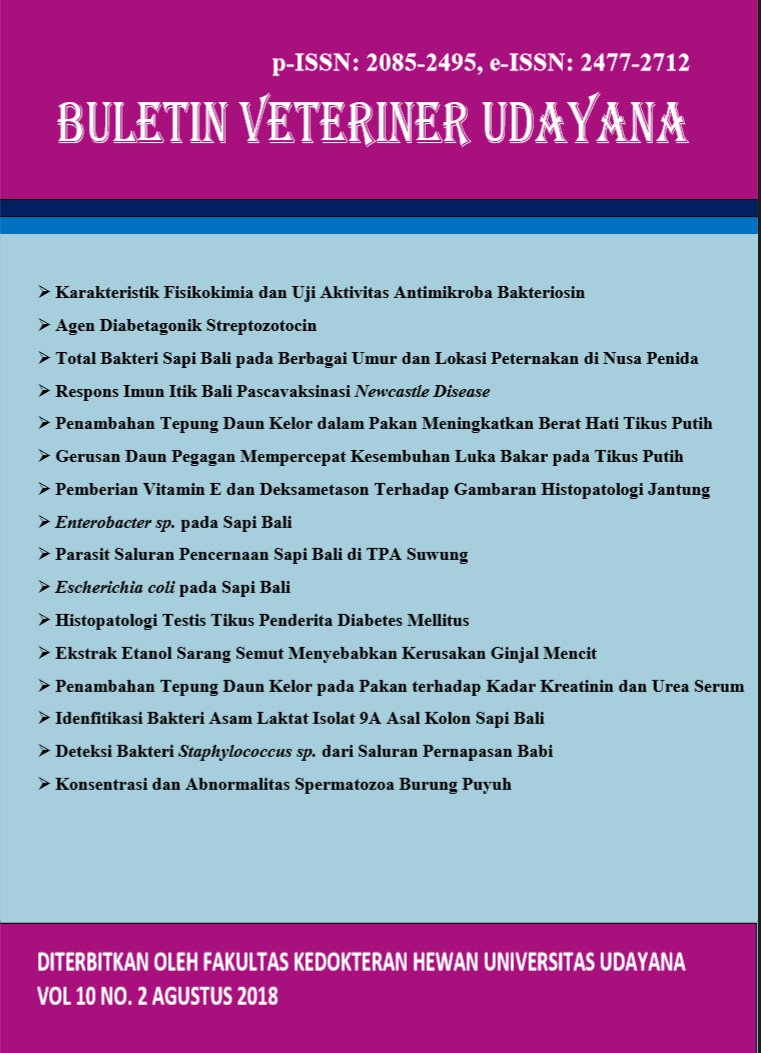IDENTIFICATION OF LACTIC ACID BACTERIA ISOLATE 9A FROM BALI CATTLE’S COLON PHENOTYPICALLY
Abstract
Lactic acid bacteria are the type of bacteria that has benefits in food and health industries as a biopreservative, fermentative, or probiotics. Bali cattle are known as potential host for specific lactic acid bacteria. The aim of this study is to identify phenotypically lactic acid bacteria 9A isolated from bali cattle’s colon, that producing a substance which known has potency as antimicrobial. In this study, phenotypic identification included conventional method and API 50 CHL. The result of this study showed that lactic acid bacteria isolate 9A was Streptococcus sp., whereas identification by kit API 50 CHL showed isolate 9A as Lactobacillus fermentum with 83% identity. The difference between the results of conventional method and kit API 50 CHL, may indicate the difference in sensitivity and specificity of the two methods, hence it needs further confirmation.
Downloads
References
Bae S, Fleet GH, Heard GM. 2006. Lactic acid bacteria associated with wine grapes from several Australian vineyards. J. Appl. Microbiol. 100: 712-727.
Gunawan IW, Suwiti NK, Sampurna P. 2016. Pengaruh Pemberian Mineral Terhadap Lingkar Dada, Panjang dan Tinggi Tubuh Sapi Bali Jantan. Bul.Vet. 8(2): 128-134.
Holzapfel WH, Haberer P, Geisen R, Björkroth J, Schillinger U. 2001. Taxonomy and important features of probiotic microorganisms in food and nutrition. Am. J. Clinic. Nutr. 73(2): 365-373.
Imen F, Manel Z, Moufida A, Naziha A, Samira A, Mouna A, Touhami K. 2016. Isolation and characterisation of lactic acid bacteria strains from raw camel milk for potential use in the production of fermented Tunisian dairy products. J. Dairy. Technol. 16(1): 103-113.
Krause DO, Smith WJ, Conlan LL, Gough JM, Williamson MA, McSweeney CS. 2003. Diet influences the ecology of lactic acid bacteria and Escherichia coli along the digestive tract of cattle: neural networks and 16S rDNA. J. Microbiol. 149(1): 57-65.
Kulwichit WS, Nilgate T, Chatsuwan S, Krajiw C, Unhasuta, Chongthaleong A. 2007. Accuracies of Leuconostoc phenotypic identification: A comparison of API systems and conventional phenotypic assays. BMC Infect. Dis. 7(1): 69.
Lindawati SA, Suardana IW. 2016. Isolasi dan Identifikasi Spesies Bakteri Asam Laktat Penghasil Senyawa Antimikrob Asal Kolon Sapi Bali. J. Vet. 17(4): 576-581.
Mantovani HC, Hu H, Worobo RW, Russell JB. 2002. Bovicin HC5, a bacteriocin from Streptococcus bovis HC5. J. Microbiol. 148(11): 3347-3352.
Moreira M, Abraham A, Antoni GD. 2000. Technological properties of milks fermented with thermophilic lactic acid bacteria at suboptimal temperature. J. Dairy. Sci. 83(3): 395-400.
Nyanga LK, Nout MJ, Gadaga TH, Theelen B, Boekhout T, Zwietering MH. 2007. Yeasts and lactic acid bacteria microbiota from masau (Ziziphus mauritiana) fruits and their fermented fruit pulp in Zimbabwe. J. Food. Microbiol. 120: 159-166.
Perdigon G, Galdeano CM, Valdez JC,Medici M. 2002.Interaction of lactic acid bacteria with the gut immune system. Europ. J. Clin. Nutr. 56(4): 21-26.
Reddy G, Altaf M, Naveena BJ, Venkateshwar M, Kumar EV. 2008. Amylolytic bacterial lactic acid fermentation-A review. J. Elsevier-Biotech. Adv. 26: 22-34.
Suardana IW, Suarsana IN, Sujaya IN, Wiryawan KG. 2007. Isolasi danidentifikasi bakteri asam laktat dari cairan rumen sapi bali sebagai kandidat biopreservatif. J. Vet. 8(4): 155-159.
Suardana IW, Suada IK, Sukada IM, Suarsana IN. 2009. Isolasi danidentifikasi bakteri asam laktat SR9 asal cairan rumen sapi bali sebagai kandidat probiotik. J. Medicina. 40(2): 100-103.
Suardana IW. 2013. Potensi Isolat Lactobacillus brevis 1 Asal Cairan Rumen Sapi Bali sebagai Sumber Senyawa Antimikroba. Proc. Seminar Nasional Sapi Bali. Pp: 87-97.
Suardana IW. 2014. Aplikasi Bakteriosin Asal Yoghurt sebagai Biopreservatif Daging Ayam pada Penyimpanan Suhu Dingin. Proc. Seminar Nasional Sains dan Teknologi. Pp: 362-372.
Suardana IW, Cahyani AP, Pinatih KJP. 2016. Probiotic potency and molecular identification of lactic acid bacteria isolated from bali cattle’s colon, Indonesia. J. Med. & Medical Sci. 5(5): 143-149.
Suryani Y, Oktavia AB, Umniyati S. 2010. Isolasi dan karakterisasi bakteri asam laktat dari limbah kotoran ayam sebagai agensi probiotik dan enzim kolesterol reduktase. J. Biota. 12 (3):177-185.
Suwiti, NK. 2009. Fenomena Jembrana Disease dan Bovine Immunodeficiency Virus Pada Sapi Bali. Bul. Vet. 1(1): 21-25.
Temmerman R, Huys G, Swings J. 2004. Identification of lactic acid bacteria: culture-dependent and culture-independent methods. J. Trends. in Food. Sci. & Tech. 15(7): 348-359.
Widodo. 2003. Bioteknologi Industri Susu. Lacticia Press: Yogyakarta
Widyadnyana DGA, Sukrama IDM, Suardana IW 2015. Identifikasi Bakteri Asam Laktat Isolat 9A dari Kolon Sapi Bali sebagai Probiotik melalui Analisis Gen 16S rRNA. J. Sain.Vet. Vol 33 (2): 228-233.
Wood BJ, Warner PJ. 2003. Genetics of lactic acid bacteria Vol 3. Springer Science & Business Media: USA.





